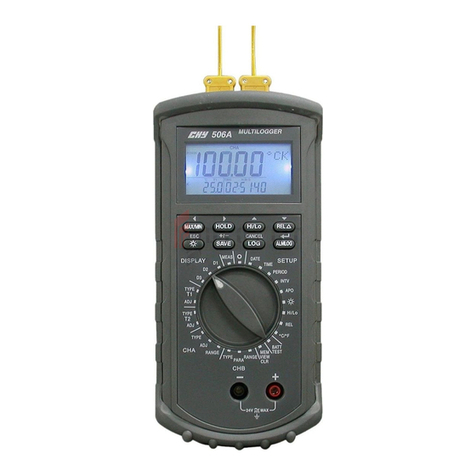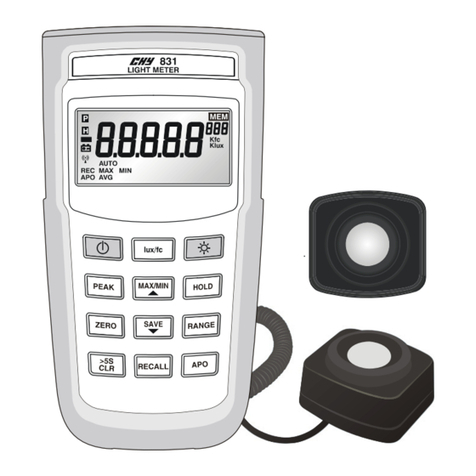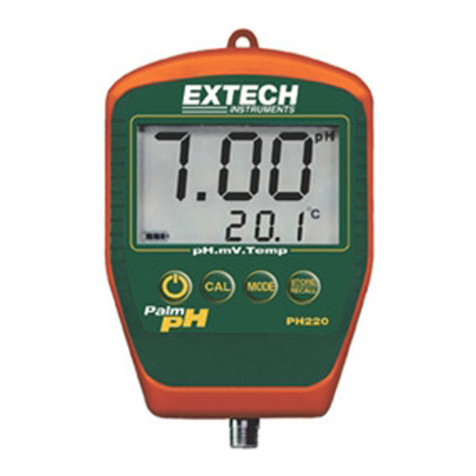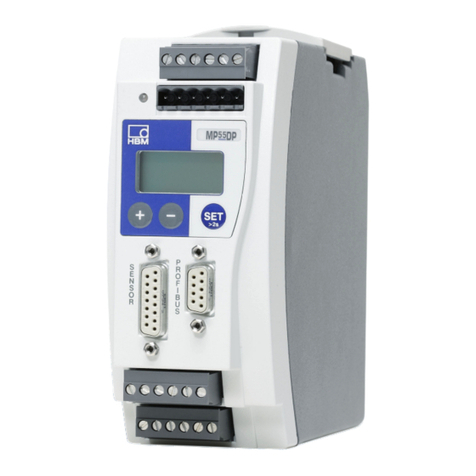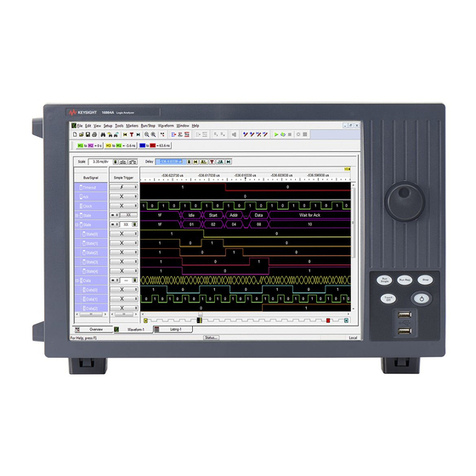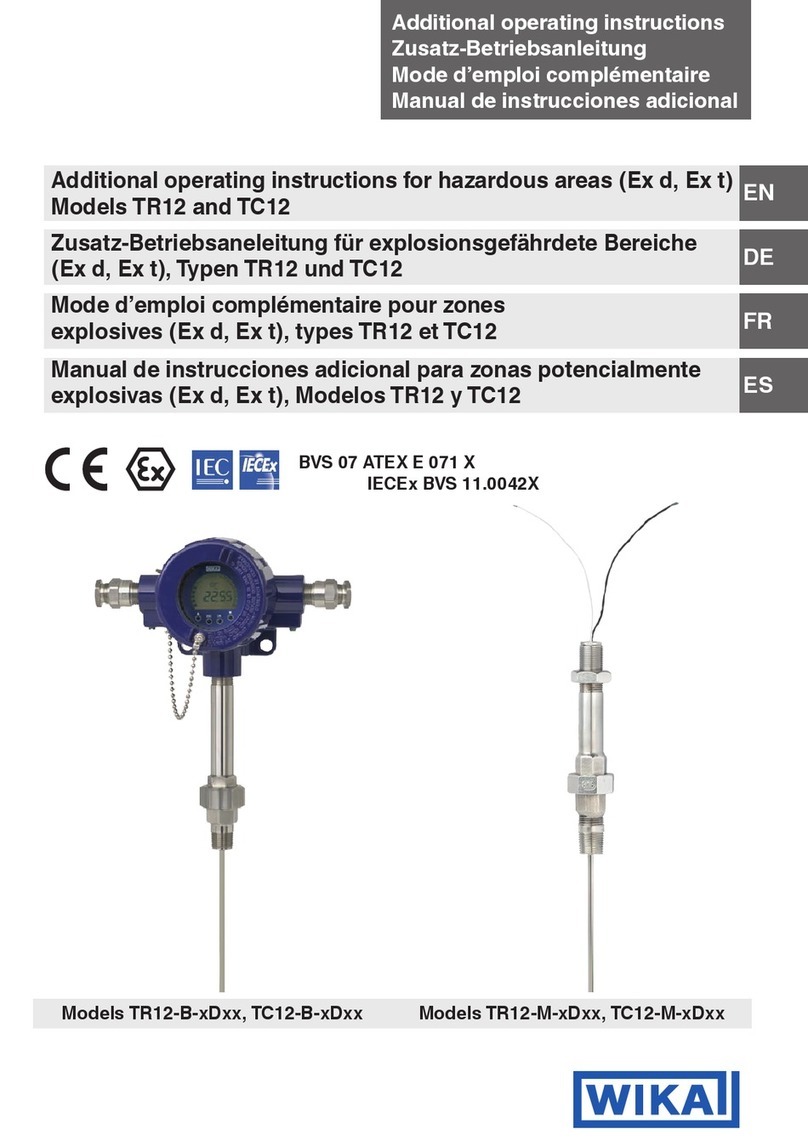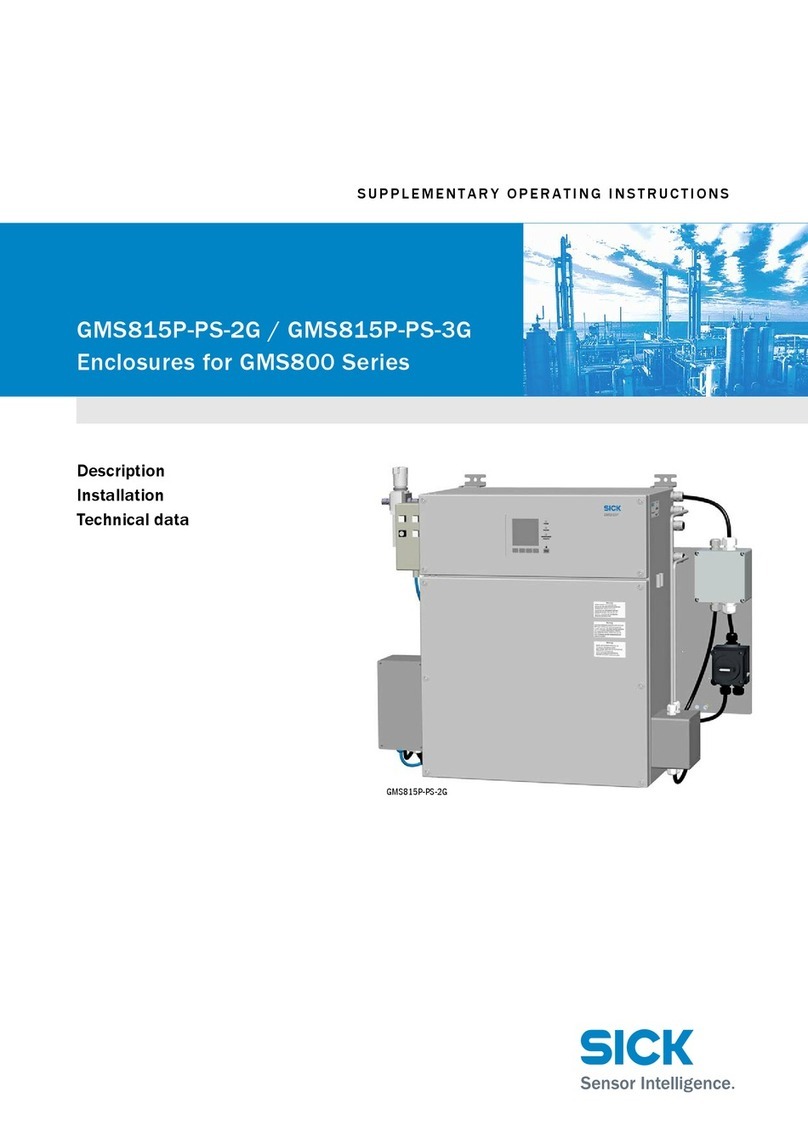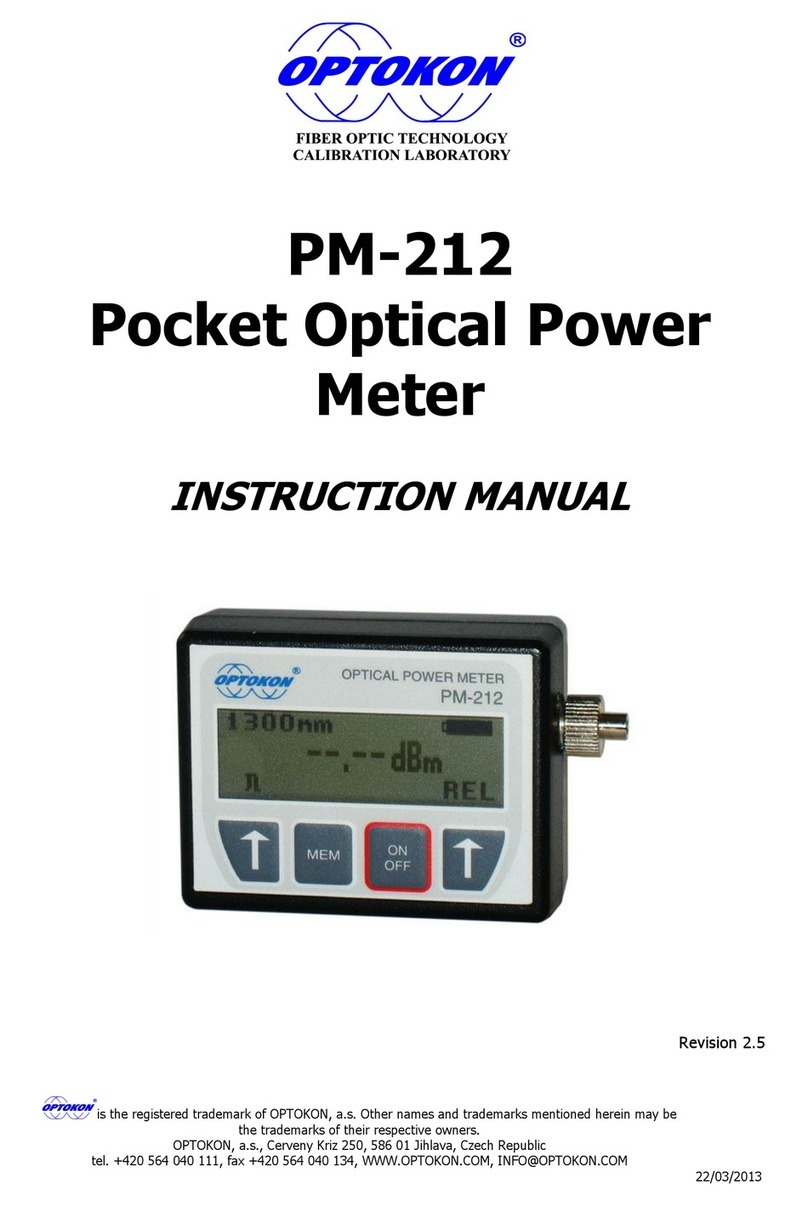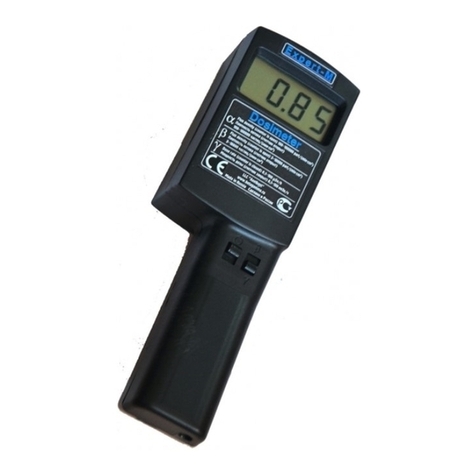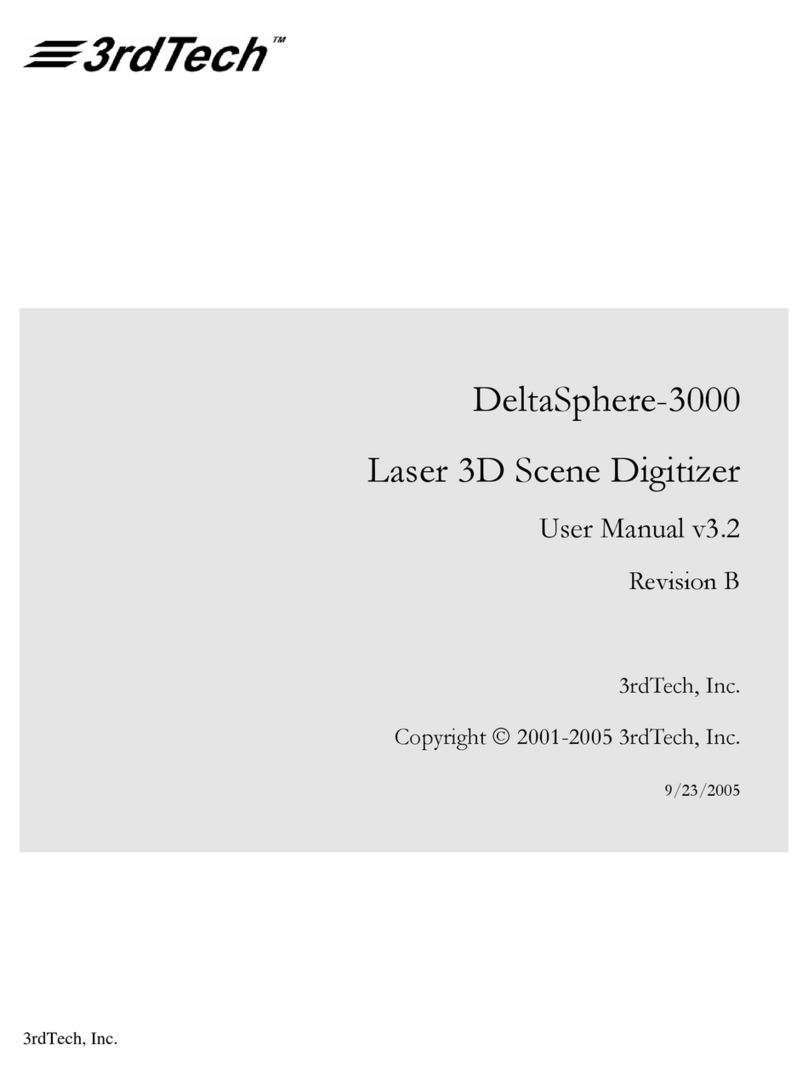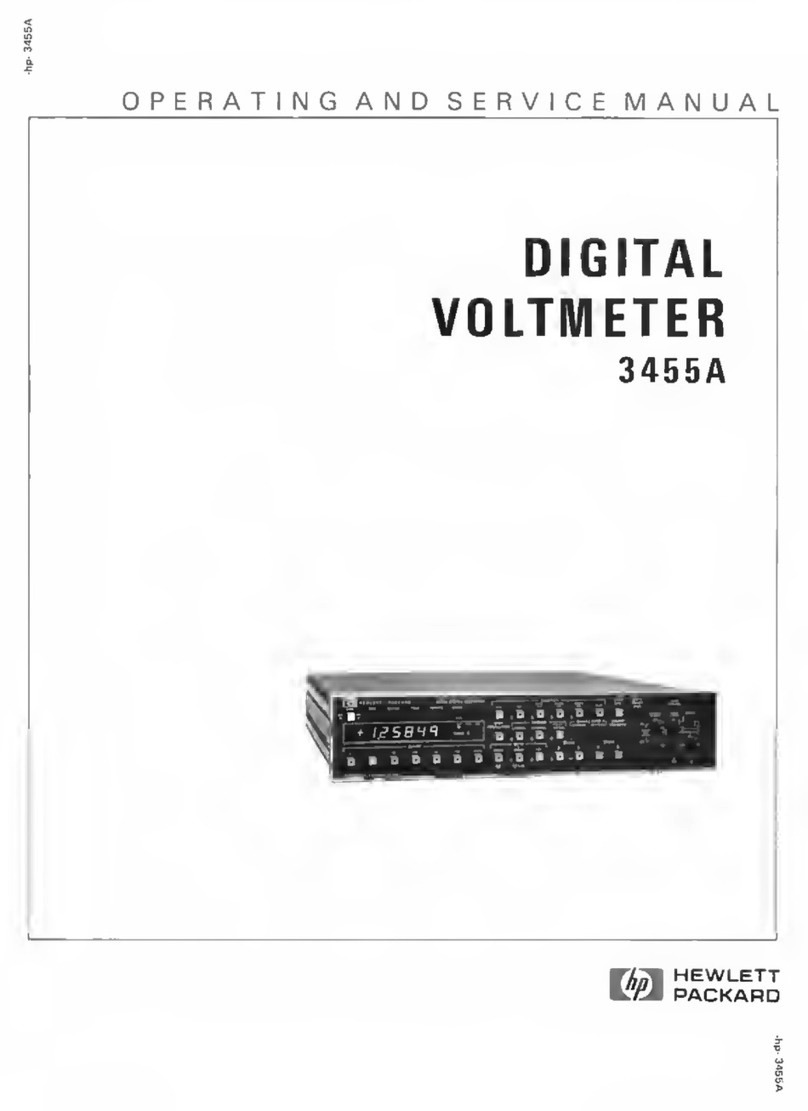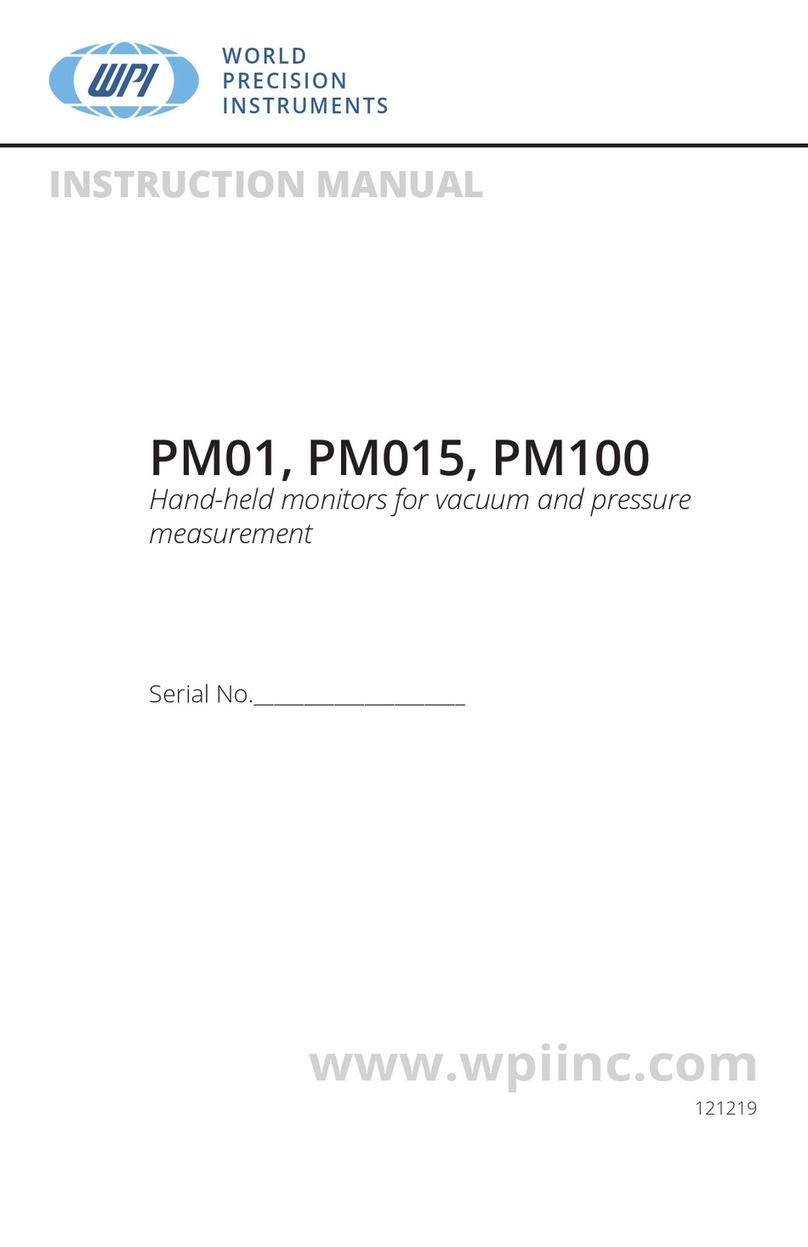CHY 48R User manual

20 Ver. 1.2 02/27/09
8. Maintenance
WARNING
Remove test leads before changing battery or fuse or performing any
servicing.
Battery Replacement:
Power is supplied by a 9 voltage “transistor” battery. (NEDA 1604 IEC 6F22). The “ ”
appears on the LCD display when replacement is needed. To replace the battery, remove the
two screws from the back of the meter and lift off the battery case. Remove the battery from
battery contacts.
Note:
It is need to replace the battery less than 1 min. to avoid the time of system was reset.
Fuse Replacement:
If no current measurements are possible, check for a blown overload protection fuse. There are
two fuses; F1 for the “mA” jack and F2 for the “10A” jack. For access to fuses, remove the
four screws from the back of the meter and lift off the battery cover and case. Replace F1 only
with the original type 0.5A/250V, fast acting ceramic fuse. Replace F2 only with the original
type 10A/600V, fast acting ceramic fuse.
Cleaning:
Periodically wipe the case with a damp cloth, detergent and do not use abrasives or solvents.
Operation Manual
MODEL 48R

19
ALMLOG READ:
Select the menu at almlog read mode and then press “SETUP” button.
Press “Sor W” or “Tor X” to page-up or page-down the data which you want.
7.2 Leaving Data Read
Press “Shift” button or switch the rotatory snitch to any position to leave Data Read Mode.
7.3 Clear Data in the Memory
Turn the rotatory switch to the position of “MEM” then press “Sor W” or “Tor X” till the
display shows “CLR” (blinks). Then push “SETUP” button to enter CLR Mode, push
“SETUP” button once to clear all data in the memory then CLR displayed at the center of the
display. All the data are deleted and all the memory counters are reset to 00000.

18
6.3.8 Thermocouple offset adjust
It can adjust temperature inaccuracy of thermocouple by user.
1. Insert thermocouple into T1 or T2 and put the sensor into a known standard, such as iced
water or boiling water.
2. Rotate the rotary switch at T1 or T2 and the adjustment procedure as follow:
Press “Shift” key - >press “SETUP” key into setup mode when the last adjustment value
displayed- >Press “SETUP” key to adjust temperature (press “▲” or “▼” to increas or
decreas reading and “W” or “X” to select field that want to adjust )->Press “Enter” key to
save the adjustment value.
7. Operation with Data Logging
The meter has 3 modes of data logging:
1. “LOG” mode: Save continuous data automatically with a set time interval. (See 6.2.4)
2. “SAVE” mode: Save individual data (See 6.2.5)
3. “ALM (Alarm) LOG”: Save the out-of-limits data automatically, limits can be set with
either itself or via Personal Computer. (See 6.2.6)
7.1 Moving among the function of Data read
When the rotatory switch at MEM position indication of “READ” blinks at lower- middle of
the display then press push button “SETUP” to read the data.
Press “Sor W” or “Tor X” to select the menu which you want.
SAVE READ →LOG READ →ALM READ
(Indication of “ALM” locates upper-left corner of the display)
7.1.1 READ OUT THE DATA
SAVE READ:
Select the menu at save read mode and then press “SETUP” button.
Press “Sor W” or “Tor X” to page-up or page-down the data which you want.
LOG READ:
Select the menu at log read mode and then press “SETUP” button.
Press “Sor W” or “Tor X” to page-up or page-down the data group which you want.
Press “SETUP” button to read the group and press “Sor W” or “Tor X” page-up or
page-down the data which you want.
TABLE OF CONTENTS PAGE
1. Safety Notice..............................................................................................................................1
2. Specifications.............................................................................................................................2
3. Names of Outer Parts................................................................................................................5
4. Turn on and off Model 48R......................................................................................................6
5. Selection of Measuring Functions............................................................................................7
5.1 Voltage and Current Measurement ..............................................................................7
5.2 ADAPTER I/P Mode Measurement..............................................................................7
5.3 CURRENT LOOP Mode Measurement........................................................................8
5.4 Temperature Measurement............................................................................................8
5.5 Resistance and Diode Measurement..............................................................................9
5.6 Continuity Test Mode (in 200Ω) Measurement............................................................9
5.7 Capacitance Measurement (Auto Range) .....................................................................9
5.8 Frequency, Duty Cycle and Pulse Width Measurement............................................10
5.8.1 Frequency Measurement (Auto range) ..............................................................10
5.8.2 Positive Duty Cycle Measurement......................................................................10
5.8.3 Positive Pulse Width Measurement....................................................................10
5.9 Logic Measurement........................................................................................................10
6. Function of Push Buttons .......................................................................................................11
6.1 Normal Mode..................................................................................................................11
6.1.1 “ ” --- Backlight.................................................................................................11
6.1.2 DC/AC selection...................................................................................................11
6.1.3 “ HHOLD” --- Data Hold...................................................................................11
6.1.4 “REL Δ” --- Setting reference value for Relative Value Measurement...........11
6.1.5 “MAX/MIN” --- MAX / NIN / MAX-MIN / AVG Function select...................12
6.1.6 “Hi/Lo” --- Alarm On or Off and min DIN output............................................12
6.1.7 “SELECT”............................................................................................................13
6.1.8 “Shift”...................................................................................................................14

6.2 Shift Mode .....................................................................................................................14
6.2.1 APO --- Enable and Disable “Auto Power Off” Function ................................14
6.2.2 SETUP ..................................................................................................................14
6.2.3 A-H (Auto Hold)...................................................................................................15
6.2.4 LOG ......................................................................................................................15
6.2.5 SAVE.....................................................................................................................15
6.2.6 ALMLOG.............................................................................................................16
6.3 Set Up Mode ...................................................................................................................16
6.3.1 Log setup...............................................................................................................16
6.3.2 Hi limit..................................................................................................................16
6.3.3 Lo limit..................................................................................................................16
6.3.4 Beeper ON/OFF ...................................................................................................17
6.3.5 Backlit (min 30 sec.).............................................................................................17
6.3.6 APO (mini 1 minute)............................................................................................17
6.3.7 Time of the system................................................................................................17
6.3.8 Thermocouple offset adjust.................................................................................18
7. Operation with Data Logging.................................................................................................18
7.1 Moving among the function of Data read.....................................................................18
7.1.1 READ OUT THE DATA.....................................................................................18
7.2 Leaving Data Read.........................................................................................................19
7.3 Clear Data in the Memory.............................................................................................19
8. Maintenance ............................................................................................................................20
17
6.3.4 Beeper ON/OFF
1. Press SETUP button to setup beeper on or off.
2. Press “S” or “T” to turn on or off the beeper function and press “SETUP”
b
utton to
confirm that the setting is completed and beeper will sound two times.
3. Press “S” or “T” to page up or page down the setup menu.
6.3.5 Backlight(min 30 Sec.)
1. Press SETUP button to setup time of backlight on.
2. Press “W” or “X” to select field.
3. Press “S” or “T” to increase or decrease the setting value and press “SETUP”
b
utton to
confirm that the setting is completed and beeper will sound two times.
4. Press “S” or “T” to page up or page down the setup menu.
6.3.6 APO(min 1 minute)
1. Press SETUP button to setup time of APO.
2. Press “W” or “X” to select field.
3. Press “S” or “T” to increase or decrease the setting value and press “SETUP”
b
utton to
confirm that the setting is completed and beeper will sound two times.
4. Press “S” or “T” to page up or page down the setup menu.
6.3.7 Time of the system
Press “SETUP” button to into setup time of system, after enter this function, the Time display
“Y : M : D” (Year : Month : Date) at the lower-right of Display changes to “H : M : S” (Hour :
Minute : Second) with number of year blinking.
Pressing “X” button to move the blinking to next number, from number of Year to Month to
Date, press “X” when number of date blinking the display changes to H : M : S with number
of Hour blinking. To move blinking to next number also by pressing “X” button. When
number is blinking, press “SETUP” button will quit the “TIME SET” function and the clock
starts from the set time. By Pressing “S” or “T” button to increase or decrease the blinking
number by 1 and circulate the numbers in following ranges.
Year: 00 to 99, Month: 01 to 12, Date: 01 to 31
Hour: 00 to 23, Minutes: 00 to 59, Second: 00 to 59
When time of the system setup is completed press “S” or “T” to page up or page down the
setup menu.

16
6.2.6 ALMLOG
In “Shift Mode”, press this button to enter “ALMLOG function”. An indicator “GRP MEM”
and a number show at lower-left corner of LCD, telling how many data had been logged in the
memory. And the indicator “LOG” shows to the right of the number telling the meter is now in
the “ALMLOG function”.
1. Measurement values above upper limit (set by user):
Beeper sounds intermittently and mini DIN output set Higher.
2. Measurement values below lower limit (set by user):
Beeper sounds continuously and mini DIN output set Lower.
3. Refer to 6.1.6 Mini-DIN output port with Photo-coupler.
Note:
1. When the “ ” is blanking, the Data Logging function is disabled. Please replace the
battery to remain the Data Logging function (ref. 8).
2. It must connect battery when you use DC transformer as main power to run datalog
function.
6.3 Set Up Mode
Press “Sor W” or “Tor X” to page-up or page-down the menu which you want.
When you into setup mode the step as follow:
6.3.1 Log setup
1. Press SETUP button to setup the interval time of data log.
2. Press “W” or “X” to select field.
3. Press “S” or “T” to increase or decrease the setting value and press “SETUP”
b
utton to
confirm that the setting is completed and beeper will sound two times.
4. Press “S” or “T” to page up or page down the setup menu.
6.3.2 Hi limit
1. Press SETUP button to setup Hi limit.
2. Press “W” or “X” to select field.
3. Press “S” or “T” to increase or decrease the setting value and press “SETUP”
b
utton to
confirm that the setting is completed and beeper will sound two times.
4. Press “S” or “T” to page up or page down the setup menu.
Note:
The setting value means the Hi limit count.
6.3.3 Lo limit
1. Press SETUP button to setup Lo limit.
2. Press “W” or “X” to select field.
3. Press “S” or “T” to increase or decrease the setting value and press “SETUP”
b
utton to
confirm that the setting is completed and beeper will sound two times.
4. Press “S” or “T” to page up or page down the setup menu.
Note:
The setting value means the low limit count.
1
1. Safety Notice
The following safety information must be observed to insure maximum personal safety during
the operation at this meter:
Warning
To avoid electrical shock, do not use this instrument when
working voltages at the measurement surface over 24V AC
or DC.
Warning
To avoid damage or burns, do not make temperature
measurement in microwave ovens.
●This instrument contains no operator serviceable part. Service should be done by qualified
person only.
●Do not use the meter if the meter or test leads look damaged, or if you suspect that the meter
is not operating properly.
●This meter is not recommended for high voltage industrial use; for example, not for
measurements of 440 VAC or 600 VAC industrial power mains. The unit is intended for use
with low energy circuits to 600VDC or AC or high energy circuit to 250 VAC or DC.
Accidental misuse by connection across a high voltage, high energy power source when the
meter is set up for mA measurement may be very hazardous.
●Turn off power to the circuit under test before cutting, unsoldering, or breaking the circuit.
Small amounts of current can be dangerous.
●Use caution when working above 60V dc or 30V ac rms. Such voltages pose a shock hazard.
●When Using the probes, keep your fingers behind the finger guards on the probes.
●Measuring voltage which exceeds the limits of the multimeter may damage the meter and
expose the operator to a shock hazard. Always recognize the meter voltage limits as stated
on the front of the meter.
●If the equipment is used in a manner not specified by the manufacturer, the protection
provided the equipment may be impaired.
●Use proper Fuse. To avoid fire hazard, use only the fuse type and rating specified for this
product.
●Do not operate without covers. To avoid personal injury, do not apply any voltage or current
to the product without the covers in place.
●Electric overload. Never apply a voltage to a connector on the product that is outside the
range specified for that connector.
●Do not operate in wet/damp conditions. To avoid electric shock, do not operate this product
in wet or damp conditions.
DANGEROUS
VOLTAGE SEE EXPLANATION
IN MANUAL
AC-ALTERNATING
CURRENT
DOUBLE
INSULATION
(Protection Class II)
DC-DIRECT
CURRENT GROUND

2
2. Specifications
Display: 4 1/2 digit liquid crystal display (LCD) with a maximum reading of 19999.
Over range: (OL) or (-OL) is displayed.
Low battery indication: The “ ” displayed and blinking when the battery voltage drops
below the operating level.
Measurement rate: 10 times per second (nominal).
Multiple signal measurement: 6500 samples with real-time data. (Max.)
ALM Record: 5400 sample with start/stop time. (Max.)
Single signal measurement: 32000 records capacity. (Max.)
Operating Environment: 0°C to 40°C at < 70% relative humidity.
Storage Temperature: -20°C to 60°C, 0 to 80% R.H. with battery removed from meter.
Safety: According to EN61010-1 protection class II over voltage category (CAT II 600V)
pollution degree 2.
Power: Single standard 9-volt battery, NEDA 1604, JIS 006P, IEC 6F22.
Battery life: 40 hours typical with carbon-zinc.
Dimensions: 192mm (H) x 91mm (W) x 52.5mm (D)
Weight: 335g including battery.
Accessories:
1. One pair test leads
2. Two K-type thermocouples
3. One spare fuse installed (500mA/250V)
4. One RS232 transmission cable
5. One CD-ROM (software)
6. One Adapter
7. 9V battery (installed) and Operating Instructions
8. Manual
Stated accuracy at 23°C ± 5°C, <75% relative humidity.
DC VOLTAGE
Range: 200mV, 2000mV/ADAPTER, 20V, 200V, 600V
Resolution: 10uV
Accuracy: ±(0.05%rdg + 5dgts)
Input impedance: 10MΩ
Overload protection: 600VDC or AC rms
AC VOLTAGE (50Hz - 500Hz)
Range: 200mV, 2000mV/ADAPTER, 20V, 200V, 600V
Resolution: 10uV
Accuracy:±(0.75%rdg + 4dgts) on 200mV to 200V ranges
±(2.0%rdg + 4dgts) on 600V range
Input impedance: 10MΩ
Overload protection: 600VDC or AC rms
15
6.2.3 A-H (Auto Hold)
In “Shift Mode”, press “HHOLD” button to change the operation mode into “Auto Hold”
Mode.
The occasions ofAuto Hold:
1. Auto Hold will not work and “H” blink when the measurement value lower then 50 counts
or OL.
2. When the new Auto Hold value has produced and the value higher the last one than 50
counts then the new one will be updated vice versa.
3. Auto Hold value will be updated when the variation of the value under 10 counts for five
times.
4. Beeper sounds two times and Hold signal displayed when new Auto Hold value produced.
6.2.4 LOG
Stand-By for Data Logging:
In “Shift Mode”, press this button to enter “Data Logging Function”. An indicator “GRP
MEM” and a number show at lower-left corner of LCD, telling how many groups of data had
been logged in the memory.
And the indicator “LOG” shows to the right of the number telling the meter is now in the
“Data Logging Function”.
Note:
1. When the “ ” is blanking, the Data Logging function is disabled. Please replace the
battery to remain the Data Logging function (ref. 8).
2. It must connect battery when you use DC transformer as main power to run datalog
function.
Start and stop Data Logging:
Once entering the “Data Logging Function”, press this button to start logging data.
Indicator “LOG” blinks to tell the meter is logging the measured data with a preset time
interval.
And indicator “GRP MEM” is substituted by SAVE Log and the number of data group stored
in the memory.
6.2.5 SAVE
In “Shift Mode”, press this button to enter “SAVE function”. An indicator “GRP MEM” and a
number show at lower-left corner of LCD, telling how many data had been saved in the
memory. And the indicator “SAVE” shows to the right of the number telling the meter is now
in the “SAVE function”.
Note:
1. When the “ ” is blanking, the Data Logging function is disabled. Please replace the
battery to remain the Data Logging function (ref. 8).
2. It must connect battery when you use DC transformer as main power to run datalog
function.

14
Enable and Disable of Auto Ranging Functions of F and Cx (Capacitance
Measurements):
Rotary Switch points to the positions F or Cx. Press this button to disable Auto Range and
change to next Range. Press and hold down the button for 2 second to enable of Auto Range.
6.1.8 “Shift” --- Shift Mode
In “Normal Mode”, press this button to enter to enter “Shift Mode”. In “Shift Mode”, press
this button to exit “Shift Mode” and return to “Normal Mode”.
6.2 Shift Mode
Press “Shift” button in “Normal Mode” to enter “Shift Mode”.
An annunciator “ S” shows at lower-right part of LCD to indicate the push button is now
working in the shift mode.
Functions of push buttons in “Shift Mode” are printed in yellow color above each button. To
leave “Shift Mode” just press the “Shift” button again or change position of the Rotary Switch
(The annunciator “ S” disappears.).
6.2.1 APO Enable and Disable “Auto Power Off” Function
When APO (Auto Power Off) is enabled, power is automatically turn off if no operation for a
p
eriod of time (factory setting = 10 min. can be reset by user). After APO, power can be
restored by turning the rotary switch.
In “Shift” Mode, press “APO” button to enable or disable “Auto-Power-Off” function. When
“Auto-Power-Off” function is enabled the annunciator “APO” shows at the upper-left corner
of LCD. Remember to press “Shift” button to leave the “Shift Mode” and return to “Normal
Mode”.
APO function will be disabled as follow:
1. External power is used.
2. RS-232 function is used.
3. MAX, MIN, MAX-MIN, AVG function is used.
4. Data logger function is used.
6.2.2 SETUP
In “Shift Mode”, press “SETUP” button to change the operation mode into “Set Up” Mode.
Press “Shift” button to leave “Set-Up” mode and return to “Normal Mode”. Please refer to
section 6.3 for the detail operation of “Set-Up” mode.
Indication of
APO enabled
Annunciator of
Shift Mode
3
DC CURRENT
Range: 200uA, 2mA, 20mA, 200mA/LOOP, 10A
Resolution: 0.1uA
Accuracy: ±(0.5%rdg + 5dgts)
Burden voltage: 325mV on all ranges, except 700mV on 10A range
Fuse rating: 0.5A/250V, 10A/600V (Fast-acting)
Overload protection: 500VDC or AC rms
AC CURRENT (50Hz - 500Hz)
Range: 200uA, 2mA, 20mA, 200mA, 10A
Accuracy: ±(0.75%rdg + 4dgts)
Burden voltage: 325mV on all ranges, except 700mV on 10A range
Fuse rating: 0.5A/250V, 10A/600V (Fast-acting)
Overload protection: 500VDC or AC rms
RESISTANCE
Range: 200Ω, 2KΩ, 20KΩ, 200KΩ, 2000KΩ, 20MΩ
Resolution: 10mΩ
Accuracy: ±(0.2%rdg + 10dgts) on 200Ω
±(0.2%rdg + 4dgts) on 2KΩto 20MΩ
Open circuit volts: 0.6VDC
Overload protection: 500VDC or AC rms
CONTINUITY (In 200Ω)
Threshold: less than 30Ω
Overload protection: 500VDC or AC rms
DIODE TEST
Range: 2000mV
Accuracy: ±(3.0%rdg + 10dgts)
Resolution: 0.1mV
Test current: 0.4mA ± 0.1mA
Open volts: 2.2VDC
FREQUENCY (Auto range)
Range: 2Hz, 20Hz, 200Hz, 2KHz, 20KHz, 200KHz, 2000KHz, 10MHz
Sensitivity: 1.0Vrms (TTL level)
Accuracy: ±(0.1%rdg + 1dgt)
Resolution: 0.0001Hz
Minimum frequency: 1.0Hz
Overload protection: 500VDC or AC rms

4
DUTY CYCLE (0.5Hz to 1KHz)
Ranges: 10.0% to 90.0%
Accuracy: ±(2.0%dgt + 5dgts) @ 2Vrms min (TTL level)
Overload protection: 500VDC or AC rms
PULSE WIDTH (1Hz to 1KHz) (Auto range)
Range: 20.00ms, 200.00ms, 2000.0ms
Sensitivity: 2.0Vrms (TTL level)
Accuracy: ±(3.0%rdg + 1dgt)
Overload protection: 500VDC or AC rms
LOGIC TEST
Threshold:
Logic Hi (S): 2.8±0.8V
Logic Lo (T): 0.8±0.5V
Frequency response: 20MHz
Overload protection: 500VDC or AC rms
CAPACITANCE (Auto range)
Cx
Range: 2000pF, 20nF, 200nF, 2uF, 20uF
Accuracy: ±(2.0%rdg + 10dgts)
F
Range: 200uF, 2mF, 15mF (Max measurement time 20 sec.)
Accuracy: ±(5.0%rdg + 5dgts)
Overload protection: 500mA/250V
TEMPERATURE (T1 / T2 / T1-T2)
Range: -50°C to 1300°C / -58°F to 2000°F
Resolution: 0.1 °C / °F
Accuracy:±(0.1%rdg + 1°C) or
±(0.1%rdg + 2°F) on T1, T2 ranges
13
6.1.7 “SELECT”:
Selection Temperature Unit (°C or °F):
Rotary Switch points to the positions T1, T2 or T1-T2. The annunciator of temperature unit °C
and °F shows at upper right corner of LCD. Press this button to toggle between °C and °F.
Switch to Adapter Function:
For adaptors with DC output:
Point Rotary Switch to the positions 2000mV and Select “DC” (see 5.2). One of the
annunciators “mV”, “A”, “°C” or “°F” shows at right hand side or upper-right corner of LCD.
When “mV” shows the meter is in the range of DC 2000 mV. When one of “A”, “°C ” or “°F ”
shows, the meter is in Adaptor Mode, to measure DC Current with an inductive current clamp
adaptor or Temperature with a Temperature Transducer plug in the jacks of VΩand COM.
Press this button to move among the functions of “mV”, “A”, “°C ” or “°F”. There are 3
ranges in Adaptor Current Measurement. Press the “SELECT” button at DC mV to enter first
range XXX.X A. In this range the display shows 1.0 A per 1mV DC input from the “VΩ” and
“COM” jacks. Press “SELECT” button again to enter 2nd range, decimal point move to
between 2nd and 3rd digits (XX.XX A), display shows 0.1 A per 1mV DC input. One more
press on “SELECT” button to enter 3rd range, decimal point move to between 1st and 2nd digits
(X.XXX A), display shows 0.01 A per 1mV DC input.
For adaptors with AC output:
Point Rotary Switch to the positions 2000mV and Select “AC” (see 5.2). The annunciators
“mV” or “A” shows at right-middle of LCD. When “mV” shows, the meter is in the range of
AC 2000 mV. When “A” shows, the meter is in Adaptor Mode, to measure AC Current, plug
the plugs of the Adaptor into the “COM” and “VΩ”. Press this button to move from “mV” to
“A”, press the button 3 times to move from “A” back to “mV”.
Switch to “Current Loop” function:
Point Rotary Switch to the positions 200mA and Select “DC” (see 5.3). If the annunciator
“mA” shows at right-middle of LCD the meter is in the range of DC 200 mA. Press this button
to switch to Current Loop function. The right-middle of the LCD shows nothing in the Current
Loop function.. Press this button again to switch back to DC 200 mA function.
Switch to “Continuity Test” Function:
Rotary Switch points to the position of “200Ω”. Press this button to toggle between 200Ωand
continuity test. The annunciator of shows at lower-left corner of LCD when in the
“Continuity Test” In this function beeper alarms when the resistance of measured object is
lower than 30Ω.
Switch among “Frequency”, “Duty Cycle” and “Pulse Width” Functions:
Rotary Switch points to the position “Hz” (Frequency). Press this key each time to change
among the functions of “Frequency” (“Hz” shows at upper-right corner of LCD), “Duty cycle”
(Nothing in the right side of LCD) and “Pulse Width” (“m” shows in the right-middle of
LCD).

12
6.1.5 “MAX/MIN” --- MAX / NIN / MAX-MIN /AVG Function select
Press “MAX/MIN” button each time to shows values of Maximum, Minimum, (Max – Min)
and average in turns. The corresponding annunciators MAX, MIN, MAX-MIN or AVG shows
below the main data. Press and hold the button for 2 second to leave this function.
In this mode, press “Hold” button to stop the recording of readings, press “HOLD” button
again to resume recording.
6.1.6 “Hi/Lo” ---Alarm On or Off and min DIN output
When alarm function is active and the “ALM” will displayed at the at the upper-left corner.
1. When measured value higher than upper limit, sound intermittent, and annunciator “S” in
LCD.
2. When measured value lower than lower limit, sound continuous, and annunciator “T” in
LCD.
3. Upper/Lower limit could be set by user (refer to 6.3.2 and 6.3.3).
There is a Mini DIN accessory on the top of this meter (photocouple) that could output Hi/Lo
signal (refer to figure 2).
Connect a voltage about 5-30V between “Pin_5” and “Pin_6” (refer to figure 3) that can start
the Hi/Lo function of Mini DIN when the alarm function is enable.
Make “Pin_5” and “Pin_6” short then the Hi/Lo function of Mini DIN will be disable.
1. Pin_1(+) and Pin_2(-) could be made short by external power (5V~30V) when the measured
value higher or equal the upper limit, Pin_3 and Pin_4 will open at the same time(hi
impedance).
2. Pin_3(+) and Pin_4(-) could be made short by external power (5V~30V) when the measured
value higher or equal the upper limit, Pin_1 and Pin_2 will open at the same time (hi
impedance).
3. Pin_1, Pin_2 and Pin_3, Pin_4 will open (hi impedance) when the measured value between
upper/lower limit.
4. The voltage /current limit of the mini DIN is 30V/5mA.
PIN_5
PIN_3
PIN_1
PIN_6
PIN_4
PIN_2
(Fig-3)
5
3. Names of Outer Parts
Front Side:
1. LCD
2. Push Buttons
3. Socket for Capacitor Sockets for Test Probes
4. Rotary Switch
5. Test Probes: A (Ampere), mA (milli Ampere), COM, VΩ
Fig. 1
1
4
5
3
2

6
Top Side:
1. Socket of Power (DC 12V)
2. RS232 (Optical Interfaced) Port
3. Min DIN output Port
4. Sockets of K type thermocouples T1
5. Sockets of K type thermocouples T2
Fig. 2
4. Turn on and off Model 48R:
Off Position
Power is off when the “Rotary Switch” points to the upper center, the position marked with
“{” Turning the Rotary Switch from the “{” position to any other position automatically
turns on Model 48R. Numbers and marks appear in the LCD Display.
When APO (Auto Power Off) is enabled (refer to 6.2.1 for enable and disable of APO), power
is automatically turn off if no operation for a period of time. (factory setting = 10 min. reset by
user).
Indication of APO
enabled.
3
2
5
1
4
11
6. Function of Push Buttons
There are three operation modes in this meter, namely, Normal Mode, Shift Mode and Setup
Mode.
Push buttons perform different functions in different operation modes.
6.1 Normal Mode
This is the default mode of the push buttons, push buttons are in this operation mode right after
the meter is turn on. Functions of push buttons in this operation mode are printed on the top of
each push button in white color.
6.1.1 “ ” --- Backlight
1. Press “ ” button to turn on and off the backlight of LCD.
2. It will auto off by setting time of backlit.
6.1.2 “ /” --- DC/AC selection
When Rotary Switch points to one of the positions of Voltage (V /) or Current Ranges
Pressing (A /).
Press “ /” button to toggle between AC and DC. The annunciator AC or DC shows at the
left-middle of LCD.
6.1.3 “HHOLD” --- Data Hold
Press “HHOLD” button to hold the data shown at that moment on the display. An annunciator
“ H” shown in the lower-right part of the display.
Press again to release the data hold and back to normal operation.
6.1.4 “RELΔ” --- Setting reference value for Relative Value Measurement
Press “RELΔ” button to store current value as the reference, next measurement will display the
relative value against this reference. An annunciator “Δ” shows at the lower-right part.
Press and hold the button for 2 sec to clean the reference value and leave the Relative Value
Measurement Mode.
Press “RELΔ” button, in Relative Value Measurement Mode, to replace the reference value
with absolute value of current measurement.
Indication of
ALM
Indication of
DC or AC
Annunciator of
MAX/MIN Mode Annunciator of
Relative Mode
Annunciator of
Data Hold Mode
Indication of
°C or °F

10
5.8 Frequency, Duty Cycle and Pulse Width Measurement
Turn the Rotary Switch to the “Hz” Range and pressing the “SELECT” push button to change
the function among Frequency, Duty Cycle and Pulse Width.
5.8.1 Frequency Measurement (Auto range)
To measure frequency, insert the test probes into the sockets of “COM” and “VΩ”.
Note:
1. Frequency Range: 2Hz, 20Hz, 200Hz, 2KHz, 20KHz, 200KHz, 2000KHz, 10MHz.
2. At low frequency measuring (less than 200 Hz), better accuracy can be obtained with square
wave.
5.8.2 Positive Duty Cycle Measurement
To measure Duty cycle, insert the test probes into the sockets of “COM” and “VΩ”.
5.8.3 Positive Pulse Width Measurement (Auto range)
To measure Pulse Width, insert the test probes into the sockets of “COM” and “VΩ”.
Note:
Pulse Width Range: 20, 200, 2000ms.
5.9 Logic Measurement
To measure frequency, insert the test probes into the sockets marked with “COM” and “VΩ” at
the lower-end of the meter and turn the Rotary Switch to one of the “ ” Range.
When measured value of voltage is TTL logic high, the annunciator “S” shows at the
left-middle of LCD.
When measured value of voltage is TTL logic low, the annunciator “T” shows at the
left-middle of LCD and sound continuous.
In this range, can be measurement frequency (auto range, TTL level):
Frequency range: 20KHz, 200KHz, 2000KHz, 10MHz
7
5. Selection of Measuring Functions
Turning the Rotary Switch to the position of the range you are going to measure. Unit (shown
at right hand side of LCD) and position of decimal point will change corresponding to the
range selected by rotary switch.
5.1 Voltage and Current Measurement
Range Selection:
Select a proper range by turning the Rotary Switch to one of the Voltage ranges (600, 200, 20,
2000m, and 200mV) or Ampere ranges (200u, 2m, 20m, 200m and 10A).
AC or DC Selection:
Pressing the “DC/AC” push button changes the range between DC and AC. Indication of
“AC” or “DC” is shown at left hand side of LCD.
Probe Positions of Voltage Measuring:
Before measuring voltage of AC or DC source the test probes should be firmly inserted in the
sockets marked with “COM” (for ground of DC source) and “VΩ”.
Probe Positions of Current Measuring:
Before measuring current of AC or DC source the test probes should be firmly inserted in the
sockets marked with “COM” and “A”(for the range of 10A) or “uA / mA” (for the ranges of
200uA, 2mA, 20mA and 200uA).
Note:
1. When measuring at range of 2000mV, due to the relatively high input impedance, Model
48R is sensitive to noise, and result in unstable at last digit. To avoid electric overload to
rotate the rotary switch the maximal range if the voltage is unknown.
2. To avoid electric overload to rotate the rotary switch the maximal range (10A) if the current
is unknown.
3. Remove power from the circuit under test and open the normal circuit path where the
measurement is to be taken.
4. Connect the meter “in series” with the circuit.
5.2 ADAPTER I/P Mode Measurement:
1. In DC 2000mV, pressing the “SELECT” push button to change the range for ADAPTER
I/P: 1A, 100mA, 10mA, °C and °F per 1mV (Ref. 6.1.7).
2. In AC 2000mV, pressing the “SELECT” push button to change the range for ADAPTER
I/P: 1A, 100mA and 10mA per 1mV (Ref. 6.1.7).

8
5.3 Current Loop Mode Measurement:
In DC 200mA, pressing the “SELECT” push button to change the range between Current and
4-20mA (as show 0.0 to 100.0) Current Loop Mode (Ref. 6.1.7).
Note:
1. Input impedance Typ. 1Ω.
2. Over-Load: 23.2mA (120.0%) “OL” displayed.
3. No indication of “%”.
5.4 Temperature Measurement
Warning
Remove test leads being measured.
There are two sets of sockets for “K type” thermocouple plugs at the top end of CHY-48R
marked with T1 and T2.To measure temperature with one channel, insert the thermo couple
into one of the socket and turn the rotary switch to the corresponding position (i.e. T1, T2 or
T1-T2).
°C and °F Selection:
When the Rotary Switch points to the ranges of T1, T2 or T1-T2, pressing the push button
“SELECT” will change the unit between °C and °F.
SELECT
Push Button
AC/DC
Indication
°C, °F, A
Indication
DC/AC
Push Button
Indication of
°C or °F
Push Button
“SELECT”
9
5.5 Resistance and Diode Measurement
To measure resistance and diode, insert the test probes into the sockets marked with “COM”
and “VΩ” at the lower-end of the meter and turn the Rotary Switch to one of the ΩRanges or
Diode Range.
Note:
1. When measuring high resistance (such as at ranges of 2MΩand 20MΩ), due to the level of
signal is very low and very sensitive to noise. Special care need to be paid to avoid the
influences of noise, especial when there is a relative long wire between the meter and
resistor to be measured.
2. The accuracy of the functions might be slightly affected, when exposed to a radiated
electromagnetic field environment, eg, radio, telephone or similar.
5.6 Continuity Test Mode (in 200Ω) Measurement
In 200Ω, pressing the “SELECT” push button to change the range between 200Ωand
continuity test.
Note:
Audible indication: less than Typ. 30.0Ω.
5.7 Capacitance Measurement (Auto Range)
To measure capacitance, turn the Rotary Switch to the range of “F” or “Cx” at the upper-left
side of the Rotary Switch and insert the lead wire of capacitor to be measured into the socket
marked with “COM” (for capacitance “-”) and “F (+)” (for capacitance “+”) or Cx. (see figure
1).
Pressing the “SELECT” push button to disenable Auto Range and change to next Range.
Note:
1. “Cx” Range: 2000pF, 20nF, 200nF, 2uF, 20uF
2. “F” Range: 200uF, 2mF, 15mF (Max. measurement time 20 sec.)
Continuity
Indication
SELECT
Push Button
Table of contents
Other CHY Measuring Instrument manuals
